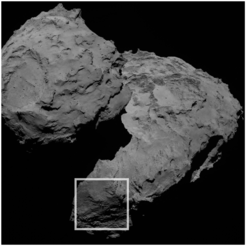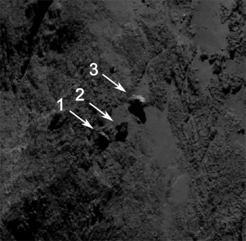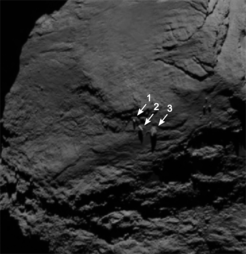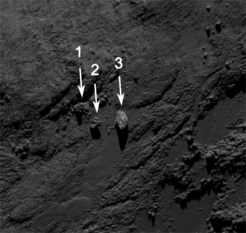OSIRIS discovers balancing rock on 67P

Scientists from Rosetta’s OSIRIS team have discovered an extraordinary formation on the larger lobe of comet 67P/Churyumov-Gerasimenko in the Aker region. From a group of three boulders the largest one with a diameter of approximately 30 meters stands out: images obtained on 16 September 2014 from a distance of 29 kilometers with the help of Rosetta’s scientific imaging system OSIRIS show it to perch on the rim of a small depression. There seems to be only a very small contact area with the nucleus.

Similar geological formations are found also on Earth. So-called balancing rocks touch the underground with only a tiny fraction of their surface and often look as if they may tilt or topple over any moment. Some can actually be rocked back and forth and are then referred to as “rocking stones.” Impressive examples of balancing rocks occur in Australia or the southwest of the USA. Often these boulders travelled to their current location onboard of glaciers. In other cases, wind and water eroded softer material surrounding the rock.
“How the potential balancing rock on the comet was formed, is not clear at this point”, says OSIRIS Principal Investigator Holger Sierks from the Max Planck Institute for Solar System Research (MPS) in Germany. It is possible that also on 67P transport processes did their part. The comet’s activity may cause such boulders to move and thus reach a new location.
„We had noticed this formation already in earlier images“, says OSIRIS scientist Sebastien Besse from ESA, who discovered the possible balancing rock. “However, at first the boulders did not seem to differ substantially from other we had seen.” Scattered boulders can be found in many places on the comet's surface. One of the largest ones measures approximately 45 meters. In reference to the Egyptian pyramids, the scientists dubbed it “Cheops”. Other regions on 67P resemble a rubble pile and are practically covered by boulders.
„Interpreting images of the comet’s surface can be tricky“, says Sierks. Depending on the viewing angle, illumination, and spatial resolution very different and sometimes even misleading impressions are created.


For example, in an image taken on 16 August 2014 (top image) from a larger distance of 105 kilometers the second boulder in the balancing rock formation appears to be protruding like a pillar. Images of the same region taken on 19 September 2014 (bottom image), however, cannot confirm his impression.
The OSIRIS scientists intend to continue to monitor the potential balancing rock carefully. New images might give insights into its true nature and maybe even its origin.
Rosetta is an ESA mission with contributions from its member states and NASA. Rosetta's Philae lander is provided by a consortium led by DLR, MPS, CNES and ASI. Rosetta is the first mission in history to rendezvous with a comet, escort it as it orbits the Sun, and deploy a lander to its surface.
The scientific imaging system OSIRIS was built by a consortium led by the Max Planck Institute for Solar System Research (Germany) in collaboration with CISAS, University of Padova (Italy), the Laboratoire d'Astrophysique de Marseille (France), the Instituto de Astrofísica de Andalucia, CSIC (Spain), the Scientific Support Office of the European Space Agency (The Netherlands), the Instituto Nacional de Técnica Aeroespacial (Spain), the Universidad Politéchnica de Madrid (Spain), the Department of Physics and Astronomy of Uppsala University (Sweden), and the Institute of Computer and Network Engineering of the TU Braunschweig (Germany). OSIRIS was financially supported by the national funding agencies of Germany (DLR), France (CNES), Italy (ASI), Spain (MEC), and Sweden (SNSB) and the ESA Technical Directorate.



